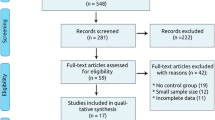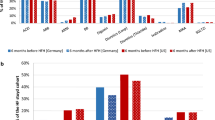Abstract
Introduction
The addition of statins to standard care in heart failure (HF) patients remains controversial in clinical practice. Large-scale clinical trials failed to show mortality benefits, but uncertainty persists in real-world settings.
Objective
We evaluated whether the prescription of statins at hospital discharge is associated with a reduction in all-cause mortality at up to 1 year of follow-up in HF patients.
Methods
We analyzed data from Epidémiologie et Pronostic de l’Insuffisance Cardiaque Aiguë en Lorraine (EPICAL2) cohort study of 2254 hospitalized acute HF patients who were admitted to 21 hospitals located in northeast France for acute HF between October 2011 and October 2012 and who received statins at discharge compared with patients who did not. We used propensity score matching and instrumental variable analyses to estimate the treatment effects of statins, and a multivariable Cox proportional-hazards model to examine survival with statin use, adjusting for patient demographics, HF characteristics, medical history, comorbidities, drug treatment and other known potential confounders. We plotted Kaplan–Meier survivor curves, and used log-rank test to determine the equality of survivor functions.
Results
We included 2032 patients in this investigation: 919 (45%) in the statin-treated group and 1113 (55%) in the control group. The estimated average statin-treatment effects for all-cause mortality in HF failed to demonstrate a significant effect on mortality [Z = − 1.73, 95% confidence interval (CI) − 0.11 to 0.007, p value = 0.083, and Z = − 0.95, 95% CI − 1.34 to 0.46, p value = 0.34] for propensity score matching and instrumental variable analyses, respectively. Moreover, the Cox proportional-hazards model showed that statin prescription was not significantly associated with the rate of death (hazard ratio = 0.85, 95% CI 0.66–1.11, p value = 0.26), adjusted for all confounders.
Conclusion
In patients with HF (and reduced or preserved ejection fraction), the prescription of statins did not appear to be associated with better survival after 1 year of follow-up in the EPICAL2 cohort. We cannot exclude that a subpopulation of HF patients may have some benefits compared with the whole HF population or that there might be a lack of power to show such effect.
Clinical Trial Registration
NCT02880358.




Similar content being viewed by others
References
Roger VL, Go AS, Lloyd-Jones DM, Benjamin EJ, Berry JD, Borden WB, et al. Heart disease and stroke statistics—2012 update: a report from the American Heart Association. Circulation. 2012;125(1):e2–220. https://doi.org/10.1161/CIR.0b013e31823ac046 (Epub 2011/12/20).
Al-Gobari M, Le HH, Fall M, Gueyffier F, Burnand B. No benefits of statins for sudden cardiac death prevention in patients with heart failure and reduced ejection fraction: a meta-analysis of randomized controlled trials. PLoS One. 2017;12(2):e0171168. https://doi.org/10.1371/journal.pone.0171168 (Epub 2017/02/07).
Kjekshus J, Apetrei E, Barrios V, Bohm M, Cleland JG, Cornel JH, et al. Rosuvastatin in older patients with systolic heart failure. N Engl J Med. 2007;357(22):2248–61. https://doi.org/10.1056/NEJMoa0706201 (Epub 2007/11/07).
Tavazzi L, Maggioni AP, Marchioli R, Barlera S, Franzosi MG, Latini R, et al. Effect of rosuvastatin in patients with chronic heart failure (the GISSI-HF trial): a randomised, double-blind, placebo-controlled trial. Lancet (London, England). 2008;372(9645):1231–9. https://doi.org/10.1016/s0140-6736(08)61240-4 (Epub 2008/09/02).
Nochioka K, Sakata Y, Miyata S, Miura M, Takada T, Tadaki S, et al. Prognostic impact of statin use in patients with heart failure and preserved ejection fraction. Circ J. 2015;79(3):574–82. https://doi.org/10.1253/circj.CJ-14-0865 (Epub 2015/03/10).
Alehagen U, Benson L, Edner M, Dahlstrom U, Lund LH. Association between use of statins and outcomes in heart failure with reduced ejection fraction: prospective propensity score matched cohort study of 21,864 patients in the Swedish Heart Failure Registry. Circ Heart Fail. 2015;8(2):252–60. https://doi.org/10.1161/circheartfailure.114.001730 (Epub 2015/01/13).
Busson A, Thilly N, Laborde-Casterot H, Alla F, Messikh Z, Clerc-Urmes I, et al. Effectiveness of guideline-consistent heart failure drug prescriptions at hospital discharge on 1-year mortality: results from the EPICAL2 cohort study. Eur J Internal Med. 2018. https://doi.org/10.1016/j.ejim.2017.12.005 (Epub 2018/01/07).
Laborde-Casterot H, Agrinier N, Zannad F, Mebazaa A, Rossignol P, Girerd N, et al. Effectiveness of a multidisciplinary heart failure disease management programme on 1-year mortality: prospective cohort study. Medicine. 2016;95(37):e4399. https://doi.org/10.1097/md.0000000000004399 (Epub 2016/09/16).
Bouvy ML, Heerdink ER, Leufkens HG, Hoes AW. Predicting mortality in patients with heart failure: a pragmatic approach. Heart (British Cardiac Society). 2003;89(6):605–9 (Epub 2003/05/16).
Maisel A, Mueller C, Adams K Jr, Anker SD, Aspromonte N, Cleland JG, et al. State of the art: using natriuretic peptide levels in clinical practice. Eur J Heart Fail. 2008;10(9):824–39. https://doi.org/10.1016/j.ejheart.2008.07.014 (Epub 2008/09/02).
Rosenbaum PR, Rubin DB. The central role of the propensity score in observational studies for causal effects. Biometrika. 1983;70(1):41–55.
Rubin DB. The design versus the analysis of observational studies for causal effects: parallels with the design of randomized trials. Stat Med. 2007;26(1):20–36. https://doi.org/10.1002/sim.2739 (Epub 2006/10/31).
Austin PC. An introduction to propensity score methods for reducing the effects of confounding in observational studies. Multivar Behav Res. 2011;46(3):399–424. https://doi.org/10.1080/00273171.2011.568786 (Epub 2011/08/06).
Becker S, Ichino A. Estimation of average treatment effects based on propensity scores. Stata J. 2002;2(4):358–77.
Austin PC. The use of propensity score methods with survival or time-to-event outcomes: reporting measures of effect similar to those used in randomized experiments. Stat Med. 2014;33(7):1242–58. https://doi.org/10.1002/sim.5984 (Epub 2013/10/15).
Garrido MM, Kelley AS, Paris J, Roza K, Meier DE, Morrison RS, et al. Methods for constructing and assessing propensity scores. Health Serv Res. 2014;49(5):1701–20. https://doi.org/10.1111/1475-6773.12182 (Epub 2014/05/02).
Al-Gobari M, Al-Aqeel S, Gueyffier F, Burnand B. Effectiveness of drug interventions to prevent sudden cardiac death in patients with heart failure and reduced ejection fraction: an overview of systematic reviews. BMJ Open. 2018;8(7):e021108. https://doi.org/10.1136/bmjopen-2017-021108 (Epub 2018/07/30).
Hopper I, Samuel R, Hayward C, Tonkin A, Krum H. Can medications be safely withdrawn in patients with stable chronic heart failure? Systematic review and meta-analysis. J Cardiac Fail. 2014;20(7):522–32. https://doi.org/10.1016/j.cardfail.2014.04.013 (Epub 2014/04/22).
Fukuta H, Goto T, Wakami K, Ohte N. The effect of statins on mortality in heart failure with preserved ejection fraction: a meta-analysis of propensity score analyses. Int J Cardiol. 2016;214:301–6. https://doi.org/10.1016/j.ijcard.2016.03.186 (Epub 2016/04/16).
Austin PC. Balance diagnostics for comparing the distribution of baseline covariates between treatment groups in propensity-score matched samples. Stat Med. 2009;28(25):3083–107. https://doi.org/10.1002/sim.3697 (Epub 2009/09/17).
Rosenbaum PR, Rubin DB. Constructing a control group using multivariate matched sampling methods that incorporate the propensity score. Am Stat. 1985;39(1):33–8. https://doi.org/10.1080/00031305.1985.10479383.
Rubin DB. Using propensity scores to help design observational studies: application to the tobacco litigation. Health Serv Outcomes Res Methodol. 2001;2(3):169–88. https://doi.org/10.1023/a:1020363010465.
Arpino B, Cannas M. Propensity score matching with clustered data. An application to the estimation of the impact of caesarean section on the Apgar score. Stat Med. 2016;35(12):2074–91. https://doi.org/10.1002/sim.6880 (Epub 2016/02/03).
Angrist JD, Krueger AB. Instrumental variables and the search for identification: from supply and demand to natural experiments. J Econ Perspect. 2001;15(4):69–85. https://doi.org/10.1257/jep.15.4.69.
Laborde-Casterot H, Agrinier N, Thilly N. Performing both propensity score and instrumental variable analyses in observational studies often leads to discrepant results: a systematic review. J Clin Epidemiol. 2015;68(10):1232–40. https://doi.org/10.1016/j.jclinepi.2015.04.003 (Epub 2015/06/01).
Luo Z, Gardiner JC, Bradley CJ. Applying propensity score methods in medical research: pitfalls and prospects. Med Care Res Rev. 2010;67(5):528–54. https://doi.org/10.1177/1077558710361486 (Epub 2010/05/06).
van Buuren S, Boshuizen HC, Knook DL. Multiple imputation of missing blood pressure covariates in survival analysis. Stat Med. 1999;18(6):681–94 (Epub 1999/04/16).
Mattei A. Estimating and using propensity score in presence of missing background data: an application to assess the impact of childbearing on wellbeing. Stat Methods Appl. 2009;18(2):257–73. https://doi.org/10.1007/s10260-007-0086-0.
Yancy CW, Jessup M, Bozkurt B, Butler J, Casey DE Jr, Drazner MH, et al. 2013 ACCF/AHA guideline for the management of heart failure: a report of the American College of Cardiology Foundation/American Heart Association Task Force on Practice Guidelines. J Am Coll Cardiol. 2013;62(16):e147–239. https://doi.org/10.1016/j.jacc.2013.05.019 (Epub 2013/06/12).
Acknowledgements
The authors thank all physicians from the 21 participating centers in the EPICAL2 clinical cohort study (Hôpitaux de Brabois et Hôpital Central, CHU Nancy; CH Luneville; Espace chirurgical Ambroise Paré Nancy; CH Alpha Santé Mont-Saint-Martin; CH Pont-à-Mousson; CH Saint-Nicolas Verdun; Hôpital Bon-Secours CHR Metz; CH Freyming Merlebach; Hôpital Sainte-Blandine Metz; Hôpital Bel Air CHR Thionville; CH Marie-Madeleine Forbach; Hôpital Alpha Santé Hayange; CH Saint-Nicolas Sarrebourg; Hôpital Lemire Saint-Avold; Hôpital des Armées Legouest Metz; Clinique Claude Bernard Metz; CH Saint-Charles Saint-Dié; CH Jean Monnet Epinal; CH Neufchateau; CH Vittel). We would also like to thank all participants and patients of EPICAL2. Special thanks are due to Patrick Taffé, statistician, for counseling.
Author information
Authors and Affiliations
Contributions
Conception and design: MA, BB, and NT. Writing the initial draft of the manuscript: MA. Contribution to writing and editing: MA, NA, BB, and NT. Critical analysis: MA, NA, MS, BB, and NT. Data management: MA and MS. Statistical analyses: MA. Proofread and approved the final version of the manuscript: MA, NA, MS, BB, and NT.
Corresponding author
Ethics declarations
Funding
The EPICAL2 cohort study received a grant from the National Hospital Program of Clinical Research (PHRC 2009) of the French Ministry of Health. MA, the corresponding author, received a financial Grant (2014.0193) from the Federal Department of Economic Affairs, Education and Research (EAER), Switzerland. All researchers were independent from funders.
Conflict of interest
The authors, MA, NA, MS, BB and NT, declare that they have no potential conflicts of interest that might be relevant to the contents of this manuscript.
Rights and permissions
About this article
Cite this article
Al-Gobari, M., Agrinier, N., Soudant, M. et al. Effects of Statins to Reduce All-Cause Mortality in Heart Failure Patients: Findings from the EPICAL2 Cohort Study. Am J Cardiovasc Drugs 19, 497–508 (2019). https://doi.org/10.1007/s40256-019-00346-4
Published:
Issue Date:
DOI: https://doi.org/10.1007/s40256-019-00346-4




